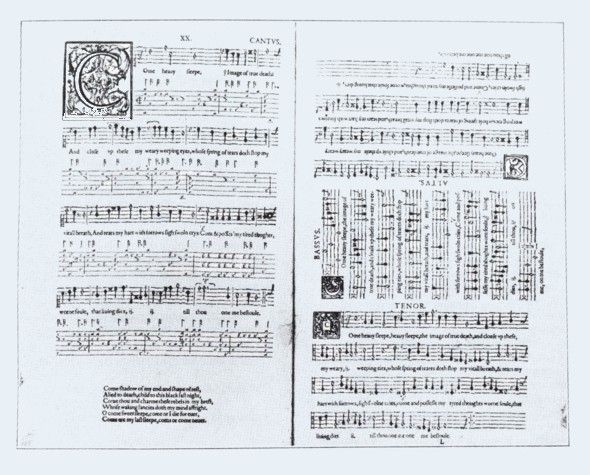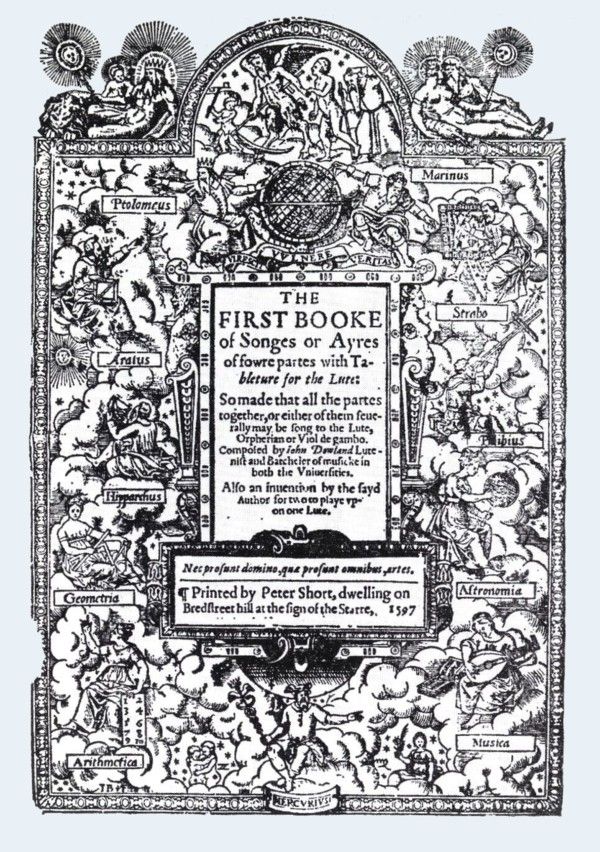

The achievements of English composers during the Middle Ages and
Renaissance were unsurpassed anywhere in Europe, though today they
still tend to be undervalued. The series Ars Britannica
explores this repertory and illustrates some of its treasures: it aims
to show the essential vitality and continuity of the English musical
tradition.
Old Hall Manuscript
Music for the House of Lancaster
The compositions on this record demonstrate all of the major genres,
techniques and styles cultivated by English composers during the early
15th century. They also evince the varied nature of English sacred
polyphony during this period.
The early 1400s saw several changes of direction in English politics
and diplomacy. With the deposition of Richard II (1367-1400) in 1399
and the accession of Henry IV (1367-1413) the direct Plantagenet line
was supplanted by the House of Lancaster. The new king was talented and
cultured, with an uncommon skill in and love for music. He passed on
many of his qualities to his four sons, the future Henry V (1387-1422),
Thomas Duke of Clarence (1388-1421), John Duke of Bedford (1389-1435)
and Humfrey Duke of Gloucester (1391-1447). He reorganised the royal
household chapel (the institution which performed the daily devotions
of the monarch and his court) to allow more emphasis on the musical
aspects of the worship; Henry V subsequently augmented its musical
personnel. Clarence, Bedford and Gloucester employed in their own
chapels some of the foremost composers of the day. While some of this
may reflect the conventional desire to advertise wealth and power
through patronage, it may well indicate a real piety and an attempt to
win divine approval for the upstart royal dynasty; it may also have
been a regal counter to the contemporary Lollard movement, with its
hostility to sacred music and liturgical elaboration.
The early Lancastrians pursued an active and at time aggressive foreign
policy. By sending English representatives to the Councils of Pisa
(1409) and Constance (1414-1418) they showed their concern for the
welfare of Christendom. Henry V's revival of the English claim to the
French crown enjoyed initial success at the battle of Agincourt (1415)
and culminated in the Treaty of Troyes (1420) by which Charles VI
recognised Henry as his heir. The early conquests and later defence
against the French counter-attack kept the royal dukes and other
English aristocrats in France as military commanders, often for months
or years at a time. English prelates and the lay nobility habitually
took their private chapels with them on their travels, and it was
probably by hearing these chapel choirs that foreign listeners became
acquainted with English music during the 1410s and 1420s. The
distinctive English sound — particularly its consonance, its full
sonority and its smoothly flowing rhythms and melodies — made a
strong impact, initiating a demand for English music which lasted until
the middle of the century and influencing the styles of Dufay, Binchois
and their colleagues.
Apart from the pieces by Dunstable, these compositions survive in the
Old Hall manuscript (London, British Library, Add, MS. 57950). One of
the few remaining insular musical sources of the period, it probably
belonged to the household chapel of Thomas, Duke of Clarence,
apparently passing to the royal household chapel after his death. It is
a collection of polyphonic settings of the Gloria, Credo, Sanctus and
Agnus, with some interpolated isorhythmic motets and votive antiphons;
most of the works are English, although there are a few pieces by
Italian and French composers. Lionel Power, Informator in Clarence's
chapel, figures prominently in the collection; little is known about
his later career although he may have become Master of the Lady Chapel
choir at Canterbury Cathedral in about 1438 (he died at Canterbury in
1445). Three of the other composers on this record were members of the
royal household chapel: John Cooke (d. 1419) and Thomas Damett
(d.-1437) from about 1413 and Robert Chirbury (d. 1454) from 1420.
Pycard was a singer in John of Gaunt's chapel in the 1390s; of Forest
nothing is known. John Dunstable may have sung in the chapel of John,
Duke of Bedford; otherwise his career is obscure. These four
compositions by him are preserved in continental sources.
Chirbury's Agnus typifies the simpler kind of Mass movement in
Old Hall, with three voices moving mainly in note-against-note fashion;
the opening chromaticism is indicated in the manuscript. Pycard's Gloria
is more elaborate; three lively voices (two of them in canon) sing the
text above two more sustained supporting lines. The animated rhythms,
canonic writing and closing hocket (the exchange of tiny motives
between the voices) attest Pycard's French training. French influence
is also evident in Power's ambitious Credo, with its parlando
passages, syncopation and ornamental dissonance; the alternation of
duet and tutti is, however, characteristically English.
Until the 1420s and 1430s, when it was supplanted by the cyclic Mass
(itself an English invention) the isorhythmic motet was the most
respected and imposing musical genre. Based on a plainsong tenor cast
in a repeating rhythmic pattern, and having two or more upper voices
usually singing different texts, its origins lay in the Parisian motet
of the early 1200s. Continental composers often gave it a secular and
ceremonial function, but in England its usage remained almost always
sacred, commonly as part of the cults of popular saints. Cooke's Alma
proles is the nearest English approach to the political motet;
invoking the protection of the Virgin and St. George against England's
enemies, it may refer to the renewal of hostilities between England and
France. Dunstable's Gaude virgo salutata (to the Virgin) and Albanus
roseo rutilat (to St. Alban) are more modern in style than Alma
proles, the lines being smoother and the dissonances more carefully
controlled; the former also adds a fourth part to the customary
three-part texture.
The votive antiphon was a non-liturgical but devotional text in Latin,
in honour of a saint or a religious theme, often sung after Compline at
the altar of the saint concerned. Damett's Salve porta and
Forest's Qualis est dilectus are addressed to the Virgin, by
far the most popular dedicatee of such pieces: the former is modest in
scale and simple in style whereas the latter is extended and
enterprising in its musical contrasts. Antiphons of the Holy Cross are
rare; Dunstable's Crux fidelis and O crux gloriosa
exemplify the mature English style of the 1420s, employing variations
of texture and metre in a consonant and mellifluous idiom.
Since there is no evidence that any instrument apart from the organ
participated in the performance of sacred music at this time, these
works are performed by voices alone, with an organ doubling some of the
sustained textless lines.

Madrigals and Lute Songs (Ayres)
Secular vocal music under Elizabeth I and James I
These two records of madrigals and ayres illustrate two aspects of a
native tradition of secular vocal music which extended back to the
earlier 16th century. They also show how certain composers reacted to
the stimulus produced by greater exposure to Italian and French music.
The madrigal was essentially a polyphonic and entirely vocal genre
which employed musical contrasts and expressive devices to reflect the
changing moods and imagery of its text. The ayre or part-song was more
homophonic, with the melody in the top voice and a strongly harmonic
bass, and it made little or no attempt to underline in the music the
nuances of the poem. Distinctions between the madrigal and ayre were
not totally rigid, however: some ayres (such as Dowland's Where sin
sore wounding from A Pilgrimes Solace, 1612 and I must
complain from The Third and Last Booke of Songs or Aires,
1603) are unusually polyphonic, while many of the lighter madrigals
(such af Weelkes' Some men desire spouses from or Phantasticke
Spirites, 1608) are almost entirely chordal. Nevertheless the
stylistic division was real, and composers worded their title pages
with care.
Like the Italian frottola and the mid-16th century French chanson, the
ayre could be performed either by a vocal group or by a solo singer
accompanied by an instrument (often a lute): John Dowland entitled his
1597 collection "The First Booke of Songs or Ayres of fowre parts with
Tableture for the Lute: So made that all the partes together, or either
of them severally may be song to the Lute, Orpherian or Viol de gambo".
Today we are so used to hearing these sung as lute-songs that we need
to guard against the assumption that this is the preferable method of
performance, whereas it is actually only one possibility. In the
interpretations on this record a cappella performance alternates with a
vocal ensemble accompanied by lute and viol, and with a solo singer
accompanied by the lute.
After its splendid flowering at the courts of Henry VII and the young
Henry VIII the secular song seems to have withered. Most of the few
songs by mid-century composers such as Tallis, Sheppard and Tye which
have survived set sententious poems either in a severely imitative
style or in simple harmonisations like those used for setting metrical
psalms. The poetry is generally pedestrian, relying excessively on long
lines and alliteration, as in Tallis' When shall my sorrowful
sighing slake.
It is understandable that the Elizabethan taste for Italian literature,
art and architecture should have extended also to music, because the
Italian madrigal offered in a mature form qualities which were either
absent from or only embryonic in the English song — a polished
and versatile contrapuntal idiom wedded to sophisticated poetry Which
had already amassed a stock of characteristic situations and images.
Printed editions of Italian madrigals were being imported into England
in the 1570s and 1580s, and Nicholas Yonge's seminal publication Musica
Transalpina (1588), an anthology of Italian madrigals with the
texts translated into English, was an avowed attempt to cater for a
growing market. The strength of the demand is indicated by the
appearance of four more Italian anthologies and some fifteen editions
by native composers such as Thomas Morley, Thomas Weelkes and John
Wilbye, all before 1600. The spate of madrigal prints gradually
decreased during the early 1600s (Pilkington's Second Set of
1624 was virtually the last significant publication); the fact that
increasing numbers of ayres were printed during the same period
suggests that the public's taste was changing.
The works in the anthologies and the compositions of the English
madrigalists themselves show a clear preference for the more
lighthearted type, often in a pastoral setting (as in Hark, jolly
shepherds from Morley's Book I of 1594). The musical intensity and
highly-charged emotionalism of Wert or Rore was generally not to the
English taste, although Ward could create an atmosphere of unusual
gravity (as in Retire, my troubled soul and O my thoughts
surcease from his Book l of 1613). With a few exceptions
English composers did not attempt the chromatic experiments of the
Italian madrigal; when they did, as in Come, woeful Orpheus
from Byrd's Psalmes, Songs and Sonnets of 1611, there is often
a sense of stylistic disunity (though in this case it is possible that
Byrd was parodying the style). The quality of the English madrigal
really lies in the fluency and charm with which elegantly-turned poetry
is set. The unobtrusive perfection of the finest examples, such as
Weelkes' Those sweet delightful lilies and Wilbye's Lady,
when I behold, makes exaggerated claims unnecessary.
Traditional traits are more evident in the ayre than in the madrigal.
The poetry tends to be more substantial, and something of the earlier
predilection for moralising or devotional texts remains (see for
example Campion's Never weather-beaten sail and Jack and Jone,
both from his First Booke of Ayres of c. 1613). Even the
simplest ayres, such as Since first I saw your face and There
is a lady (both from Thomas Ford's Musicke of Sundrie Kindes
of 1607) are pithy in a way which belies their apparent artlessness.
The more ambitious pieces, like Dowland's I must complain,
strike the listener with unusual force, partly through the solemnity of
their contrapuntal style.
